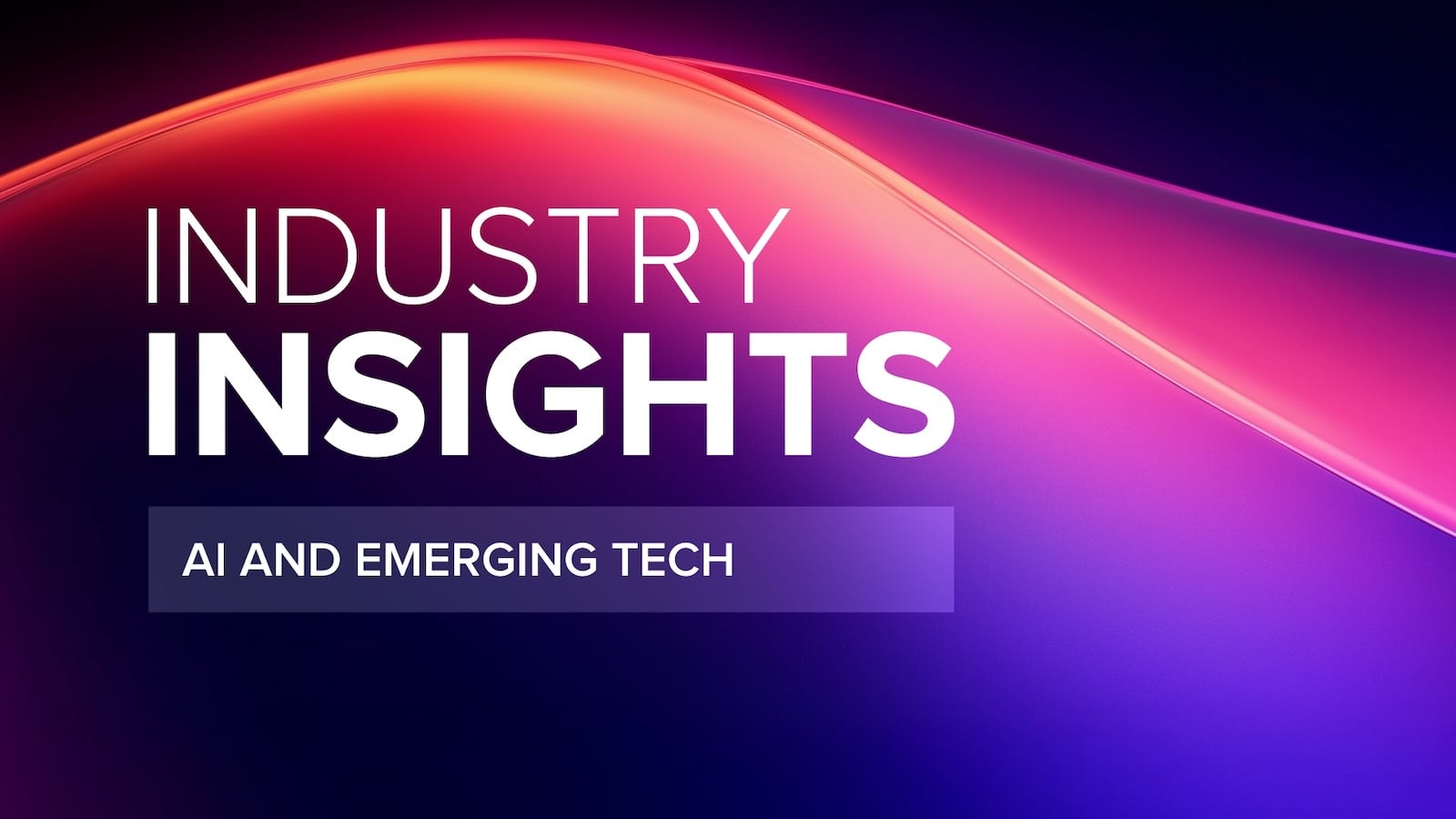Industry Insights: AI’s impact on personalization, monetization and advertising

Subscribe to NCS for the latest news, project case studies and product announcements in broadcast technology, creative design and engineering delivered to your inbox.
In this second installment of the Industry Insights roundtable on AI and emerging tech, technology vendors examine how artificial intelligence changes content personalization and monetization in broadcasting.
The discussion explores AI’s role in analyzing viewer behavior, optimizing advertising placement, and enhancing content recommendations. Industry experts address the balance between personalization and privacy while examining how predictive analytics help broadcasters maximize revenue through targeted advertising and subscription models.
The conversation also delves into AI applications for rights management and compliance monitoring, highlighting the technology’s impact on operational efficiency and revenue generation.
Key takeaways from this Industry Insights roundtable
- Personalization: AI-driven content recommendation systems analyze viewing habits to deliver customized programming, resulting in increased viewer engagement and retention.
- Monetization: Broadcasters utilize AI to optimize advertising placement, develop subscription models, and create targeted content packages that generate new revenue streams.
- Analytics: Predictive modeling helps determine optimal ad placement by analyzing peak engagement periods and viewer behavior patterns.
- Rights Management: AI automates content tracking and compliance monitoring across platforms while ensuring adherence to licensing agreements and regional regulations.
- Ethics: Implementation of AI-driven personalization requires careful consideration of data privacy, transparency, and potential algorithmic bias.
How does AI-driven content recommendation impact viewer retention and satisfaction?
Siddarth Gupta, principal engineer, Interra Systems: AI-driven content recommendation taps into users’ viewing habits to deliver highly personalized programming and leads to stronger engagement. Suggesting relevant shows or stories can boost watch time and overall viewer satisfaction. This personalized approach also fosters loyalty, ensuring audiences remain connected to a particular network or platform.
Kathy Klinger, CMO, Brightcove: By analyzing vast amounts of data, AI ensures viewers are presented with content they’re most likely to enjoy, keeping them engaged and reducing churn. This creates a seamless, personalized experience that resonates with individual preferences, making it easier for audiences to discover and connect with new content. In turn, it strengthens viewer loyalty and empowers creators and platforms to deliver greater value to their audiences.
Sam Bogoch, CEO, Axle AI: The most successful OTT platform, Netflix, relies heavily on AI-driven content recommendation and has clearly benefited from it in terms of market share and profitability. Likewise, in the world of media websites and apps, YouTube and TikTok are also leveraging AI-driven recommendations to further their success. It’s clear that any successful viewer retention and growth strategy should at least have AI and rich content metadata as a key ingredient.
Noa Magrisso, AI developer, TAG Video Systems: By tailoring suggestions to individual tastes, these algorithms ensure relevant content is surfaced quickly, reducing decision fatigue. This personalized approach increases engagement, as viewers are more likely to stay on the platform and discover enjoyable experiences. Ultimately, it provides broadcasters and streaming platforms with a significant competitive edge.
Simon Parkinson, managing director, Dot Group: AI can improve viewer engagement, both in terms of retention and satisfaction. To enhance viewer satisfaction during Wimbledon, IBM Consulting created a system, known as “Catch Me Up,” created with a generative AI model built with IBM Watsonx, that is fueled by Wimbledon’s trusted data sources, and has been trained to describe the game of tennis and Wimbledon in particular. The summaries are personalized to a fan’s favorite players and appear on the home page of the Wimbledon app and website to ensure that the content they’re consuming is the content that they’re really looking for.
How can AI help broadcasters tailor content to individual viewer preferences?
Stefan Lederer, CEO and co-founder, Bitmovin: Not only is AI already proving to be invaluable at analyzing content in real time to enable contextually relevant ads that closely match the content being viewed, but it’s also being used by broadcasters to offer hyper-personalized recommendations. And we know that video providers are already using AI to analyze user behavior at a deep level to make accurate content recommendations. With the use of AI, this can be done at such speed that it becomes possible to deliver dynamic content recommendations that meet a viewer’s ever-changing preferences.
Costa Nikols, strategy advisor, media and entertainment, Telos Alliance: AI’s ability to analyze huge datasets in real time has the potential to help fine-tune content delivery in new ways. By using AI to enhance the value of metadata, broadcasters can move toward deeper audience segmentation and personalization while supporting multi-language distribution. For instance, a viewer, or set of viewers, may prefer softer background noise or alternative language commentary tracks for a sporting event — AI may well help make this level of customization at scale more feasible and economical.
Dave Dembowski, SVP of global sales, Operative: AI can help broadcasters tailor viewer experiences by analyzing data and using insights to deliver more relevant content — on streaming this can be done at the household level by analyzing viewer history, something Netflix and Amazon do very well. For linear programming, large language models or LLMs like ChatGPT can be used to search the internet for ratings, reviews, searches, and more to see what kinds of content viewers like. AI can also help layer these viewer insights with other data such as location or demographic data so broadcasters can create smart forecasts of viewership to help with more tailored content schedules to specific audiences.
Simon Parkinson: As we enter the era of hyper-personalization, creating an experience that enhances viewer satisfaction, and subsequently viewer retention, is key in creating a competitive advantage within the industry. In fact, according to McKinsey, 67% of consumers say they are frustrated when their interactions with businesses aren’t tailored to their needs. AI models can analyze previous interactions with websites and other channels to provide a tailor-made experience to build a relationship with the consumer and improve customer retention by delivering content that is specifically relevant to them.
What are the ethical considerations when using AI for personalized content delivery?
Kathy Klinger: Platforms must ensure that user data is handled securely and that AI recommendations do not reinforce biases or create echo chambers. Transparency in how algorithms operate is essential to maintaining user trust and promoting informed engagement. By addressing these challenges, companies can deliver personalized experiences responsibly while respecting ethical boundaries.
Simon Parkinson: When building trustworthy AI, there are several ethical considerations to bear in mind. When delivering AI generated/summarized content, it is imperative that privacy, transparency and any form of bias can be addressed and remediated before implementation. With hyper-personalized content, there is a risk around manipulation and steering consumers into certain choices or opinions, and so it is once again essential that the data powering the AI model has been sufficiently vetted and curated to remove any form of inadvertent bias.
How can AI improve content monetization strategies for broadcasters?
Stefan Lederer: AI’s ability to efficiently and accurately search, tag and categorize content can be used to help surface content that closely aligns individual viewer preferences, and that may otherwise remain hidden. Similarly, the same process can also be applied to repurpose existing content by locating hidden or archived content to create new content for themed programming or anniversaries. Additionally, AI can also be used to unlock new advertising revenue potential through AI-powered contextual advertising.
Siddarth Gupta: By analyzing viewer data, AI is able to pinpoint content that resonates with audiences the most, which helps video service providers better tailor paywalls or tiered subscriptions. Personalized ad insertion further maximizes revenue by matching ads to individual preferences or the type of content being viewed at the time. This dynamic targeting helps broadcasters capture new revenue streams and increases customer interest in the suggested viewing.
Yang Cai, CEO and president, VisualOn: AI can enhance content monetization for broadcasters by enabling dynamic ad insertion, ensuring more relevant ads and driving higher engagement and revenue. It also uses predictive analytics to forecast audience demand and optimize content licensing and subscription models, increasing profitability. Additionally, AI helps broadcasters streamline operations, reducing costs and freeing up resources for further investment in content creation and monetization opportunities.
Kathy Klinger: AI can optimize ad placements, fine-tune targeting to ensure ads reach the right audiences and allow broadcasters to maximize ad revenue. By analyzing viewer behavior, AI can also recommend subscription models and personalized content packages, opening up new revenue streams. This approach helps broadcasters stay ahead of trends, enhancing profitability while providing more value to viewers and fostering long-term loyalty.
Zeenal Thakare, SVP, enterprise solutions architecture, Ateliere: Monetization strategies that will take front row seats with AI include content licensing and distribution optimization, sponsorship and brand integrations, targeted subscription and pay per view and bundle models, all driven by audience analytics, behavioral targeting and predictive analytics. By leveraging AI for deeper insights into audience behavior, automating processes and enhancing engagement, broadcasters can create more lucrative and efficient monetization strategies — whether through ads, subscriptions, sponsorships or new innovative formats.
Dave Dembowski: Broadcasters can leverage AI to learn more about their viewers, which can help them create attractive products and packages for advertisers. AI also helps broadcasters create more accurate forecasts for both viewer and advertiser demand, which can help them create smarter pricing strategies. AI can help broadcasters know what to sell up front, at what price, and what inventory to hold back based on likely demand closer to delivery.
What role does predictive analytics play in optimizing ad placements and campaigns?
Stefan Lederer: For ads to be effective, firstly, they need to be highly relevant to the viewer and secondly, they need to be delivered at the point when the viewer is most receptive. AI can support with both of these elements. With AI-based contextual advertising, content is analyzed in real time, so ads can be shown that align closely with what the viewer is watching at any precise moment. This ensures ads are relevant and appropriate to the viewer’s mood.
Siddarth Gupta: Predictive models analyze audience behavior to determine peak engagement periods and relevant content categories, ensuring ads are placed whenever viewers are most receptive. This increases the rate of conversion, helping broadcasters maximize their advertising ROI and refine campaigns in real-time.
Dave Dembowski: Predictive analytics helps broadcasters get a more accurate picture of future viewer behavior and future advertiser demand. AI predictive analytics can evaluate huge amounts of data to understand these two shifting factors and how they interact. Broadcasters can use predictive analytics to sell more at better prices and deliver more accurately for less under-delivery and fewer make goods.
How are broadcasters leveraging AI for rights management and compliance monitoring?
Stefan Lederer: Digital rights management is an essential part of the video workflow, involving mechanisms such as encryption, access control, license management, rights enforcement and monitoring. With AI, broadcasters can automate many of the manual and time-consuming tasks involved in these processes such as contract analysis, monitoring content usage in real time to ensure rights are being enforced and analyzing data to detect potential breaches. Just as we’re seeing across other areas of the industry, AI has the potential to deliver huge time savings in the digital rights management space.
Yang Cai: Broadcasters are using AI to streamline rights management and compliance monitoring by automating the tracking of content and ensuring it aligns with licensing agreements. AI-powered solutions can monitor live broadcasts and on-demand content to ensure compliance with regional laws, including geo-blocking and ad restrictions. Furthermore, AI assists in detecting unauthorized content usage, minimizing copyright violations, and enhancing the enforcement of rights.
Zeenal Thakare: This will include real-time monitoring across platforms, conflict resolution and tracking. Another key aspect is going to be compliance monitoring and copyright enforcement. Lastly, given the global nature of the audience, AI-powered data privacy management is going to be key.
Subscribe to NCS for the latest news, project case studies and product announcements in broadcast technology, creative design and engineering delivered to your inbox.








tags
Artificial Intelligence, Ateliere, Ateliere Creative Technologies, Axle AI, Bitmovin, Blackmagic Design, Brightcove, Broadcast Monetization, Costa Nikols, Dave Dembowski, Dot Group, Interra Systems, Kathy Klinger, Noa Magrisso, Operative, panasonic, Panasonic Connect, Quicklink, Sam Bogoch, Siddarth Gupta, Simon Parkinson, Sony, Stefan Lederer, TAG Video Systems, Telos Alliance, VisualOn, Vizrt, Yang Cai, Zeenal Thakare
categories
Advertising, Broadcast Automation, Heroes, Industry Insights, Voices